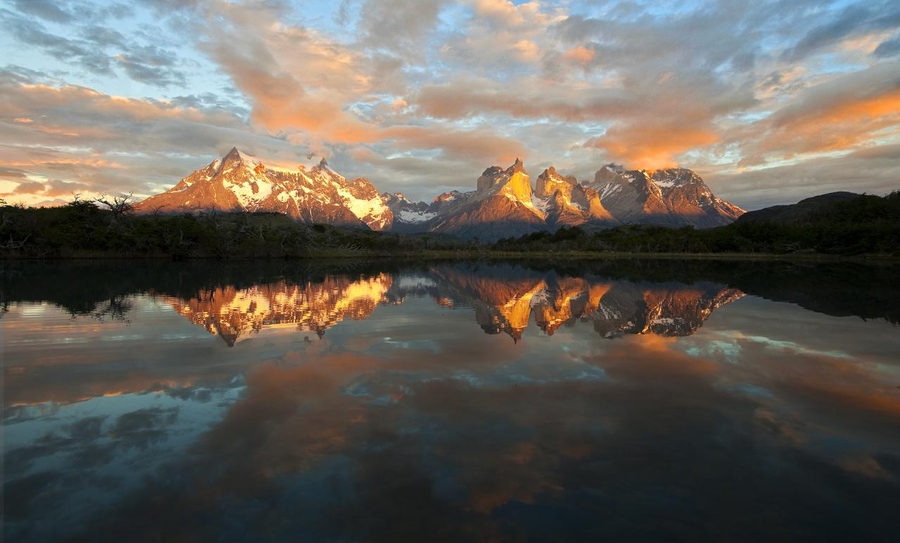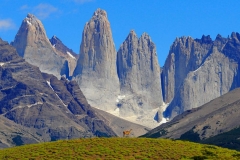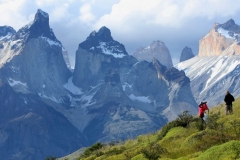
Sufficient grandeur and beauty all around. Mountains cloaked in southern beech trees stretched for mile after mile on either side of the road, rising to peaks of 10,000ft or 13,000ft, many capped with snow or glaciers. At Aisén’s latitude, the Andes are no longer a neat chain, as the watershed collapses into a jagged coastal landscape and rivers flow in all directions. As you drive, you occasionally catch a teasing glimpse of the northern ice field – a 1,600-square mile mega-glacier left over from the last ice age, and the source of all the changeable weather.
Lago General Carrera, the second-biggest lake in South America (after Titicaca), which Chile shares with Argentina (where it’s called Lago Buenos Aires). Spreading out over an immense valley, it is 60 miles long, 21 miles wide and nearly 2,000ft deep – and it is turquoise. The lake is affecting because of its ubiquity – it becomes your companion for days as you drive –
Drive along a side-road to the much smaller Lago Tranquilo, parked, and set off to do a circuit. This lake is also turquoise and its surroundings even more tranquilo than those of the big one.
Río Baker, Chile’s most voluminous watercourse. At its source, on the southern edge of Lago Bertrand, you see the river fast gaining speed and strength, the emerald waters churning up into whitetops and complex eddies patterning the surface. In a boat you can visit the confluence of the Baker and the Río Neff, which comes down from the ice field. The Extreme South & Tierra del Fuego
El Chalten, is a major hiking destination in the Southern Andes with ambitious trekkers taking on the challenge of Mount Fitz Roy and Cerro Torres, two of the biggest peaks in Patagonia. It’s busy in the summer but pretty quiet the rest of the year apart from a steady stream of travellers backpacking through Argentina and Chile.
El Calafate (for Los Glaciares National Park). Just 2-3 hours driving from El Chalten, this is also a major base for trekkers in Argentine Patagonia looking to explore the fabulous Glaciers National Park. Entrance to the park isn’t cheap and is only valid for a day but plenty of different trips can be arranged in El Calafate to witness the incredible giant glaciers.
Torres del Paine national park. You are now really approaching the chilly Southern tip of the continent and Torres del Paine National Park is home to plenty of stunning mountains, glaciers, lakes, and rivers. There are many campsites, some of which are free. Camping in non-designated areas is strictly not allowed.
Punta Arenas, is the most southerly city on mainland South America. The weather can make exploring the town pretty difficult but there is a surprising amount of history and sites of interest. You can also get to the Seno Otway penguin colony where each spring hundreds of Magellanic Penguins come to breed. Meanwhile there is a good view of some incredible whales from Carlos III Island.
Ushuaia (Tierra del Fuego)Ushuaia is commonly referred to as the southernmost city in the world and a thriving tourism industry has built up in recent years focused around the cruises to Antarctica. The town is now complete with nice restaurants and given its military history there are some cool museums to visit such as Museo Marítimo set in an old prison. Nearby Tierra del Fuego National Park is also an incredible place to explore and this is fast becoming a popular stop on many backpacking routes in Argentina and indeed South America.
Destinations
- Santiago
- Santa Cruz
- Pichilemu
- Siete Tazas
- Pucón
- Puerto Varas
- San Martin
- Bariloche
- Esquel
- Futalefú
- Coihaique
- Chile Chico
- Perito Moreno
- El Chaltén
- Calafate
- Torres del Paine
- Punta Arenas
- Ushuaya
Best time to do from September to March.


